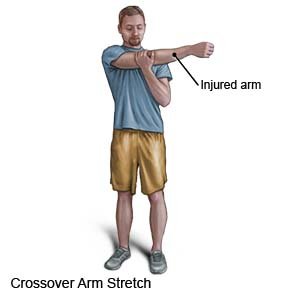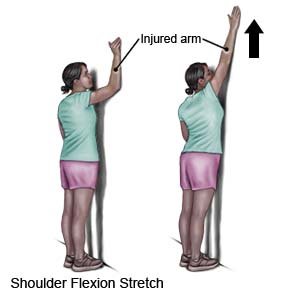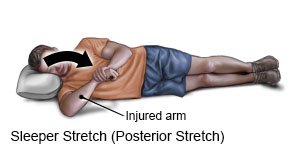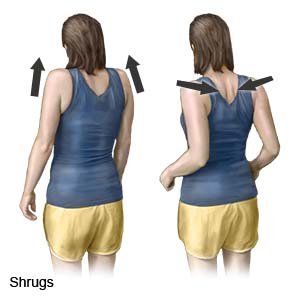Early Postoperative or Post Injury Shoulder Exercises
Medically reviewed by Drugs.com. Last updated on Apr 6, 2025.
What do I need to know about starting an exercise program after surgery or an injury?
You may need to wait until your swelling and pain have gone down before you start to exercise. Do not start an exercise program before you talk to your healthcare provider.
What should I do before I exercise?
Warm up and stretch before you exercise. Walk or ride a stationary bike for 5 to 10 minutes to help you warm up. Stretching helps increase range of motion. It may also decrease muscle soreness and help prevent another injury. Your healthcare provider or physical therapist will tell you which of the following stretches to do:
- Crossover arm stretch: Relax your shoulders. Hold your upper arm with the opposite hand. Pull your arm across your chest until you feel a stretch. Hold the stretch for 30 seconds. Return to the starting position.

- Shoulder flexion stretch: Stand facing a wall. Slowly walk your fingers up the wall until you feel a stretch. Hold the stretch for 30 seconds. Return to the starting position.

- Sleeper stretch: Lie on your injured side on a firm, flat surface. Bend the elbow of your injured arm 90° with your hand facing up. Use your arm that is not injured to slowly push your injured arm down. Stop when you feel a stretch at the back of your injured shoulder. Hold the stretch for 30 seconds. Slowly return to the starting position.

How do I perform exercises without a weight or an exercise band?
- Pendulum swings: Lean forward and rest the arm that is not injured on a table. Do not round your back or lock your knees during the exercise. Let your other arm hang freely by your side. Gently swing your injured arm forward and backward, side to side, and in circles.

- Shrugs: Stand with your arms by your side. Gently lift your shoulders up to your ears and hold for 5 seconds. With your shoulders lifted, pinch your shoulder blades together. Hold for 5 seconds. Slowly return to the starting position.

How do I perform exercises with a weight?
Your healthcare provider or physical therapist will tell you how much weight to use. You may need to start with a light weight and work up to heavier weights. Hold a weight with your arm slightly in front of your body. Slowly raise your arm to the side with your thumb pointing up or down as directed. Stop when you reach the level of your shoulder. Hold for as many seconds as directed. Slowly return to the starting position.
How do I perform exercises with an exercise band?
Your healthcare provider or physical therapist will tell you how much resistance to use.
- Hold the exercise band with both hands in front of your body. Slowly raise your injured arm up and to the side with your thumb pointing up or down as directed. Stop when you reach the level of your shoulder. Hold for as many seconds as directed. Slowly return to the starting position.
- Tie one end of the exercise band to a heavy object. Stand and hold the band in your hand. Bend your elbow. Keep your arm close to your side and pull the band straight back. Squeeze your shoulder blades together as you pull. Slowly return to the starting position.
When should I call my doctor or physical therapist?
- You have sharp or worsening pain during exercise or at rest.
- You have questions or concerns about your shoulder exercises.
Care Agreement
You have the right to help plan your care. Learn about your health condition and how it may be treated. Discuss treatment options with your healthcare providers to decide what care you want to receive. You always have the right to refuse treatment. The above information is an educational aid only. It is not intended as medical advice for individual conditions or treatments. Talk to your doctor, nurse or pharmacist before following any medical regimen to see if it is safe and effective for you.© Copyright Merative 2025 Information is for End User's use only and may not be sold, redistributed or otherwise used for commercial purposes.
Learn more about Early Postoperative or Post Injury Shoulder Exercises
Care guides
Further information
Always consult your healthcare provider to ensure the information displayed on this page applies to your personal circumstances.
